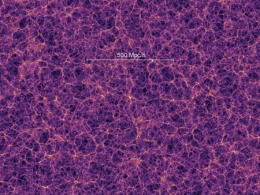Simulations based on the standard cosmological model, as shown here, indicate that on very large distance scales, galaxies should be uniformly distributed. But observations show a clumpier distribution than expected. (The length bar represents about 2.3 billion light years.) Credit: Courtesy of Volker Springel/Max-Planck-Institute for Astrophysics, Garching, Germany (via PRL)
(PhysOrg.com) -- After analyzing data from the Sloan Digital Sky Survey (SDSK), cosmologist Shaun Thomas and colleagues from the University College of London, have concluded that the universe is "clumpier" than scientists have thought, leading to speculation that new theories need to be made to explain why the matter that makes up the universe isn’t as smooth as models have suggested they should be. The results of their research, published on Physical Review Letters, show that there is either faulty evidence in their discovery, or that established laws of gravity do not apply to such a large scale as the entire universe.
Such models, created by cosmologists to show how the universe came to be as it is today, are based on Einstein’s theory of general relativity, and use known data about the universe; starting from the Big Bang and moving forward, to recreate, in essence the entire time from back then, till now. In so doing, and by applying the laws of motion and gravity, scientists are able to duplicate the process that led to way matter exists in the universe, which because it all came from the singularity known as the Big Bang, theory suggests that there should be a certain uniformity everywhere you look, the only irregularities coming from fluctuations in the density of matter itself.
This new research upends that idea though, showing that there exists far more clumps of stuff such as stars and galaxies then there should be if everything has been moving, since the Big Bang, according to the laws of physics.
Thomas and his team made the find by analyzing data from the SDSK, creating a 3-D map in the process, of galaxies some 4 billion light years distant, then calculated the smoothness of what they saw and compared that to what models suggested they should find. To their surprise they discovered that instead of the normal 1% clumpiness that models suggest, they instead found differences as much as 2%, which is significant because it moves their findings out of the realm of simple calculation errors.
Clearly it’s far too early to start throwing out Einstein’s theories, or even to rethink dark matter or how other elements that make up the universe might impact it’s clumpiness, as this is but one study, and there are other factors that might have caused the discrepancy, such as the difficulty in seeing through the Milky Way galaxy to what lies beyond, or inaccurate estimates of which little bits of light out there are stars or whole other galaxies. More studies, using data from other studies will need to be done before anything definitive can be declared and agreed upon.
More information: Excess Clustering on Large Scales in the MegaZ DR7 Photometric Redshift Survey, Phys. Rev. Lett. 106, 241301 (2011) DOI:10.1103/PhysRevLett.106.241301
Abstract
We observe a large excess of power in the statistical clustering of luminous red galaxies in the photometric SDSS galaxy sample called MegaZ DR7. This is seen over the lowest multipoles in the angular power spectra Cℓ in four equally spaced redshift bins between 0.45≤z≤0.65. However, it is most prominent in the highest redshift band at ∼4σ and it emerges at an effective scale k≲0.01 h Mpc-1. Given that MegaZ DR7 is the largest cosmic volume galaxy survey to date (3.3(Gpch-1)3) this implies an anomaly on the largest physical scales probed by galaxies. Alternatively, this signature could be a consequence of it appearing at the most systematically susceptible redshift. There are several explanations for this excess power that range from systematics to new physics. We test the survey, data, and excess power, as well as possible origins.
© 2010 PhysOrg.com






















